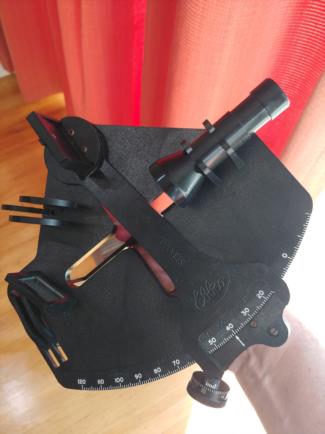
NavList:
A Community Devoted to the Preservation and Practice of Celestial Navigation and Other Methods of Traditional Wayfinding
From: Murray Buckman
Date: 2023 Dec 14, 16:59 -0800
Pictured is an Ebbco Special, which I purchased new in 1982 as a backup to my primary sextant. Before I had satellite navigation available on the boats I sailed and raced, it came with me on every trip, just in case I dropped its much more expensive cousin overboard or otherwise damaged it beyond use. That never happened and the Ebbco never came out of its box. After SatNav and then GPS it made a few more trips (I left the "nice" sextant at home) but in time it went into the cupboard and stayed there.
During the pandemic I took three sextants out to play with (the Ebbco, a 1950s Heath and a 1980s Tamaya) and, over three days, took a series of morning and afternoon sun sights with each, all from the back yard with a simple tray of water as an artificial horizon. On each day, one of the sextants was used for the meridian sights - so each got used once at noon. This was almost forty years after I had bought the Ebbco. These were my first sights with it - ever.
As you might expect, all position lines passed close to my actual (GPS) position. If they hadn't, I would have been worried. But it turned out that on two of the three days, including the day where the Ebbco was also used for the meridian passage sight, it produced the tightest cross of the three position lines and was closest to the actual position, with two of the three lines passing across the actual position - pencil lead accuracy - and the third (the noon sight) passing 1 minute to the south. This was using a universal plotting sheet covering 2 degrees of latitude on a piece of landscape letter size (similar to A4) paper.
What does this mean? Nothing really - it was just a bit of fun while working from home. To be honest, having two position lines cross at the actual position is probably as much an indicator of error as it is of accuracy. With a deck that does not move, a perfect (artificial) horizon, and plotting on paper at this scale, errors with single-handed timekeeping, the pencil, ruler and dividers are as significant, or more significant, as poor sights, a cheap sextant with minimal adjustments and the theoretical accuracy of the sight reduction method. It does not mean that the cheapish plastic sextant is more "accurate" than the Heath and Tamaya it was compared with. It just means it got lucky on the day.
But it does go to show that somebody wanting to try their hand at celestial navigation, but reluctant or unable to buy an expensive sextant, should not hesitate to go with the plastic option. The Ebbco can still be found second hand, but expect to replace the shades and resilver or replace mirrors. It is a step up (somewhat) from the Davis Mark 3. Much newer Davis Mk 15 sextants can be found at reasonable prices. It also means that if I ever found myself without electronics in the middle of the ocean I would have no qualms about relying on my now forty + years old Ebbco plastic sextant.
Murray B.







